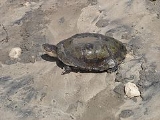
Pelomedusidae
Encyclopedia
- Alternatively, "Pelomedusidae" may refer to the Pelomedusoidea. See below for details.
Pelomedusidae is a family
Family (biology)
In biological classification, family is* a taxonomic rank. Other well-known ranks are life, domain, kingdom, phylum, class, order, genus, and species, with family fitting between order and genus. As for the other well-known ranks, there is the option of an immediately lower rank, indicated by the...
of freshwater turtle
Turtle
Turtles are reptiles of the order Testudines , characterised by a special bony or cartilaginous shell developed from their ribs that acts as a shield...
s, native to eastern and southern Africa. They range in size from 12 centimetres (4.7 in) to 45 centimetres (17.7 in) in shell length, and are generally roundish in shape. They are unable to fully withdraw their heads into their shells, instead drawing it to the side and folding it beneath the upper edge of the shell, and hence are called African side-necked turtles.
The family contains a mere two living genera
Genera
Genera is a commercial operating system and development environment for Lisp machines developed by Symbolics. It is essentially a fork of an earlier operating system originating on the MIT AI Lab's Lisp machines which Symbolics had used in common with LMI and Texas Instruments...
. They are distinguished from their closest relatives by a hinge in the front section of the plastron
Pelomedusidae spend most of their time in the mud at the bottom of rivers or shallow lakes, where they eat invertebrates such as insects, molluscs, and worms. Many species aestivate through the dry season, burying themselves in the mud.
Systematics and taxonomy
The related PodocnemididaePodocnemididae
Podocnemididae is a family of turtles native to Madagascar and northern South America. They are side-necked turtles , which means they do not retract their heads backwards, but hide it sideways....
are either treated as a distinct family, or as a subfamily (Podocnemidinae) in the Pelomedusidae. The African side-necked turtles are then also demoted to subfamily rank, as Pelomedusinae.
As taxonomic rank
Taxonomic rank
In biological classification, rank is the level in a taxonomic hierarchy. Examples of taxonomic ranks are species, genus, family, and class. Each rank subsumes under it a number of less general categories...
is only meaningful as part of a sequence (a biological "family" has no fixed meaning on its own), both treatments are technically correct. Ultimately, the issue hinges upon the Austro-American sideneck turtles (Chelidae
Chelidae
The Chelidae are one of the three living families of the turtle suborder Pleurodira and are commonly called the Austro-South American Side Neck turtles. The Family is distributed in Australia, New Guinea, parts of Indonesia and throughout most of South America. It is a large family of turtles with...
). These Pleurodira
Pleurodira
The Pleurodira are one of the two living suborders of turtles, the other being the Cryptodira. In many cases in the nomenclature of animals, ranks such as suborder are considered of little importance apart from nomenclatural or taxonomic reasons. However, this is not the case with the suborders of...
are less closely related to the Podocnemididae and Pelomedusidae than these are to each other. If all three are ranked as full families, the Chelidae are treated as a basal lineage, while the other two are united in the superfamily
Taxonomic rank
In biological classification, rank is the level in a taxonomic hierarchy. Examples of taxonomic ranks are species, genus, family, and class. Each rank subsumes under it a number of less general categories...
Pelomedusoidea. This treatment is preferred here, because it allows to place prehistoric pleurodires (e.g. the Bothremydidae
Bothremydidae
Bothremydidae is an extinct family of side-necked turtle. They belong to sub-order Pleurodira and order Testudines. Bothremydidae lived in fresh water and were amphibious. They were actively mobile omnivores.-Taxonomy:...
) more conveniently.

